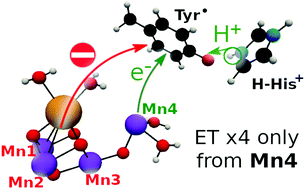Charge separation and successive reconfigurations of electronic and protonic states in a water-splitting catalytic cycle with the Mn4CaO5 cluster. On the mechanism of water splitting in PSII†
Abstract
Much insight into the basic mechanisms of photoexcited and collision-induced ground-state water splitting has been accumulated in our nonadiabatic electron wavepacket dynamics studies based on a building-block approach reaching up to systems of binuclear Mn oxo complexes. We here extend the study to a ground-state water-splitting catalytic cycle with tetranuclear Mn oxo complex Mn4CaO5, or Mn3Ca(H2O)2(OH)4–OH–Mn(4)(H2O)2, where Mn3Ca(H2O)2(OH)4 is fixed to a skewed cubic structure by μ-hydroxo bridges and is tied to the terminal group Mn(4)(H2O)2. We show using the method of real-time nonadiabatic electron wavepacket dynamics that four charge separation steps always take place only through the terminal group Mn(4)(H2O)2 alone, thereby producing 4 electrons and 4 protons which are transported to the acceptors. Each of the three charge separation steps is followed by a reloading process from the skewed cubic structure, by which electrons and protons are refilled to the vacant terminal group so that the next charge separation dynamics can resume. After the fourth charge separation an oxygen molecule is generated. It is emphasized that the mechanisms of O2 generation should depend on the multiple channels of reloading.



 Please wait while we load your content...
Please wait while we load your content...